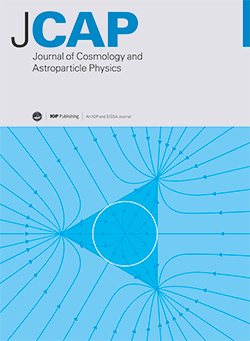The spectrum of gravitational waves from annihilating domain walls
IF 5.3
2区 物理与天体物理
Q1 ASTRONOMY & ASTROPHYSICS
Journal of Cosmology and Astroparticle Physics
Pub Date : 2025-07-15
DOI:10.1088/1475-7516/2025/07/049
引用次数: 0
Abstract
Networks of cosmic domain walls can form in the early Universe as a consequence of the spontaneous breaking of discrete symmetries. We study the production of a cosmological background of gravitational waves (GWs) from such networks, when they annihilate due to a small explicit symmetry breaking term. Averaging over several 3+1-dimensional high-resolution lattice field simulations, we obtain a GW spectrum with the following characteristics: (1) a broad asymmetric peak, roughly located at frequency (at the time of emission) f ∼ 2Hgw, where Hgw is the Hubble rate at the end of GW production, shortly after annihilation, (2) a doubly broken power law spectrum ∝ k-n, with initial slope n ∼ 0.5 after the main peak and n ∼ 1.8 at high f, while the low frequency region f < fp agrees with the causality behavior ∼ k3. Additionally, extending previous results, we find that GW production continues to be efficient until a value of the Hubble scale Hgw that is roughly an order of magnitude smaller than the naive estimate σH = ΔV, where σ is the wall tension and ΔV, the size of the symmetry breaking term, thereby leading to a O(100) larger GW signal. We find such results to be robust when changing the shape of the scalar field potential or including a time-dependent symmetry breaking term. Our findings have important implications for GW searches, especially in light of the reported evidence for a stochastic GW background in Pulsar Timing Array data.湮灭畴壁产生的引力波谱
宇宙域壁网络可以在早期宇宙中形成,这是离散对称性自发破断的结果。我们研究了引力波(GWs)宇宙背景的产生,当它们由于一个小的显式对称破缺项而湮灭时。对几个3+1维高分辨率晶格场模拟进行平均,我们获得了具有以下特征的GW谱:(1)一个宽的不对称峰,大致位于频率(发射时)f ~ 2Hgw,其中Hgw是湮灭后不久GW产生结束时的哈勃速率;(2)一个双破幂律谱∝k-n,主峰后的初始斜率为n ~ 0.5,高f处的初始斜率为n ~ 1.8,而低频区f < fp符合因果关系行为~ k3。此外,扩展之前的结果,我们发现GW的产生仍然是有效的,直到哈勃尺度的Hgw值大约比原始估计的σ h = ΔV小一个数量级,其中σ是壁张力,ΔV是对称破断项的大小,从而导致GW信号大0(100)。我们发现当改变标量场势的形状或包含随时间变化的对称性破缺项时,这样的结果是稳健的。我们的研究结果对GW搜索具有重要意义,特别是考虑到脉冲星定时阵列数据中随机GW背景的证据。
本文章由计算机程序翻译,如有差异,请以英文原文为准。
求助全文
约1分钟内获得全文
求助全文
来源期刊

Journal of Cosmology and Astroparticle Physics
地学天文-天文与天体物理
CiteScore
10.20
自引率
23.40%
发文量
632
审稿时长
1 months
期刊介绍:
Journal of Cosmology and Astroparticle Physics (JCAP) encompasses theoretical, observational and experimental areas as well as computation and simulation. The journal covers the latest developments in the theory of all fundamental interactions and their cosmological implications (e.g. M-theory and cosmology, brane cosmology). JCAP''s coverage also includes topics such as formation, dynamics and clustering of galaxies, pre-galactic star formation, x-ray astronomy, radio astronomy, gravitational lensing, active galactic nuclei, intergalactic and interstellar matter.
 求助内容:
求助内容: 应助结果提醒方式:
应助结果提醒方式:


